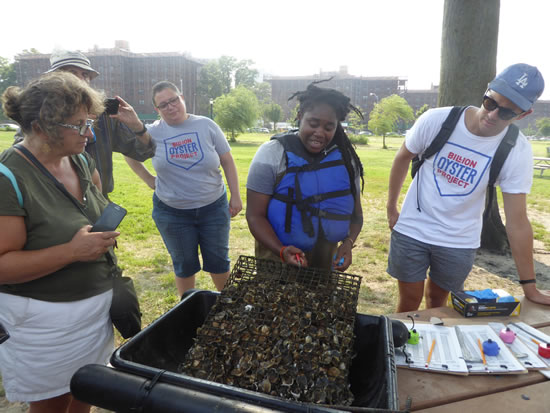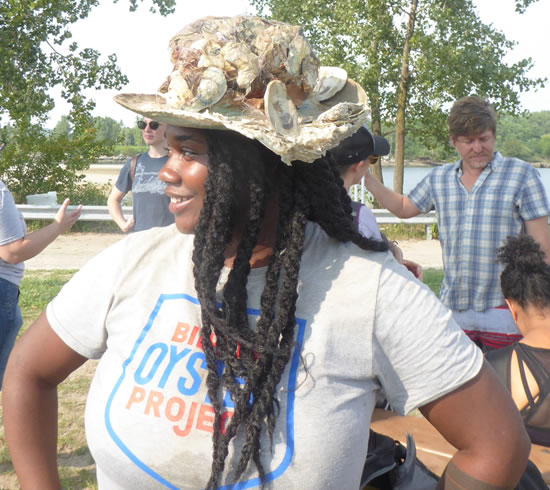The Oyster Queen: Restoring NYC’s Oyster Reefs
By Dr. Merryl Kafka, NYS Marine Education Association (NYSMEA.org)

Teacher training session to measure the oysters
Tanasia Swift, a regional site manager from The Billion Oyster Project (BOP), is like the Johnny Appleseed of the water world. Her days are busy “planting” oyster reefs in NYC’s estuaries, from Coney Island to Sunset Park, Governor’s Island, and the Bronx River. Tanasia is determined and excited, like a mother of millions, to see the success of her efforts. She recruits and trains an army of students and teachers in the classroom and in the field to help establish reefs, and monitor and collect data on the growth of these incredible mollusks.
New York City and the American Oyster (Crassostrea virginica) have had a long and delicious, but difficult history, with oysters occupying over 350 square miles in the lower estuary of NYC. Historically, NYC provided the world with the best-tasting oysters, with many of them harvested right from Brooklyn’s Gowanus Canal! Now the canal is one of the most polluted waterways in the country! By the early 1900s, over one billion oysters a year were being harvested from our local waters. However, long-term threats such as overharvesting; rapidly growing urbanization; altering our coastlines from original marshlands and rocky shores to hard edges, bulkheads and piers; dredging and landfill projects; and the discharge of pollution meant doomsday to our oyster beds.
Oysters were an integral part of our city: as a food source for all classes — the impoverished and the elite, with fine-dining oyster taverns, to basement “oyster cellars”, and street vendors selling them for a penny a piece; its lime-rich shells were ground up and burnt to construct Trinity Church; and Pearl Street is named for the huge piles of oysters left by the Lenape.

Tanasia Swift, Oyster Reef Site Manager
It is the intention of the Billion Oyster Project (BOP) to restore the oysters to NYC. Not as a food source due to polluted urban waters, but to have the oysters help restore a healthy waterway. The oyster is a living filter, each one filtering 50 gallons of water per day. Oysters feed on algae, and different species live in either fresh water, brackish, or salt-water ecosystems.
Creating oyster reefs also help to restore and maintain our biodiversity. The oyster is a keystone species, creating a habitat for many organisms that live on or near oyster beds and their associated complex community of microorganisms, worms, crabs, barnacles, sea stars, and fish.
Coney Island Creek is one of the newest installations, containing about 140,000 oysters, housed in 28 mesh cages called “files” to create a Community Oyster Reef. All Community Oyster Reefs must receive a permit from the Department of Environmental Conservation (NYSDEC). The Coney Island Community Oyster Reef was permitted under the condition that the oysters must be removed before they become “market size” to avoid the public from poaching and eating oysters from the contaminated waters.
The reef is organized like a file cabinet, with each “file” or rack of oysters containing a number and a color code. The students at the Harbor School, located on Governor’s Island, is an important part of the behind-the-scenes development and maintenance of the oyster production. Students learn how to care for the planktonic oyster larvae, and the later stage called spat, that is ready to settle on a hard substrate. The most preferred substrate for the spat to cement itself onto is an established living reef or a dead pile of oyster shells called cultch, creating a foundation for a new colony. Many New York City restaurants donated over a million pounds of oyster shells to prepare for reef installations.
Tanasia uses the oysters as a way to teach students about the scientific method, science content and field skills, ecology of our local waters, and conservation ethics to preserve our marine heritage.
On the first day of our training, BOP Staff and 12 teachers eagerly appeared, representing schools from PS 288, John Dewey HS, Rachel Carson HS, Pace University, Bloomington School of Music, as well as staff from the Nature Conservancy and the Waterfront Alliance, allies in the BOP campaign. #
Tentative Reef Monitoring Schedule*
Tuesday, November 6th, 11:30am–2:00pm: Canarsie Reef
Wednesday, November 7th, 12:15pm–2:15pm: Coney Island Reef
Friday, November 23rd, 12:30pm–2:30pm: Coney Island Reef
*Note: Dates are tentative.
Please contact Tanasia Swift to RSVP. For information to participate in reef monitoring events, please contact our Queen of Oysters, Tanasia Swift: Tswift@nyharbor.org
